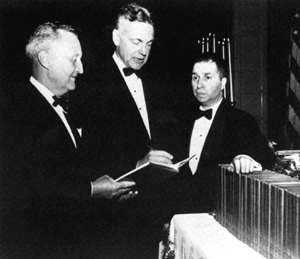A good read about the Great Books
Long before Oprah’s Book Club, there was…
By Mary Ruth Yoe
Photo courtesy Special Collections Research Center
“Quick,” I command an office mate. “Tell me what the Great Books mean to you.” Startled at the question, she hastily offers, “They’re the classics, the books you read in the core, the ones Hutchins talked about.” If I’d asked, she would have named names. Thucydides, Shakespeare, Freud. But she would not have mentioned the 54-volume set that the University, in partnership with the Encyclopædia Britannica, published in 1952 as the Great Books of the Western World.

Benton, Hutchins, Adler, and a set of what Hutchins called “colorful furniture.”
Those Great Books comprised 443 works (by 74 authors, all dead and male, most white) crammed into 32,000 pages of double-columned, 9-point type (the type you’re reading, perhaps with some difficulty, is 9.5 points). They are the subject of a new book with a title almost as long as the 62-inch, rainbow-hued set itself: A Great Idea at the Time: The Rise, Fall, and Curious Afterlife of the Great Books (Public Affairs). Written by Boston Globe columnist Alex Beam, A Great Idea at the Time is a lively look at a mid-20th-century phenom now almost forgotten.
The business venture was rooted in Robert M. Hutchins’s belief that “[t]he aim of education is wisdom,” an enlightenment achieved via Socratic dialogue centered on great texts. Within a year of arriving at Chicago as the nation’s youngest university president, Hutchins and his sidekick, philosopher Mortimer Adler, were leading 20 undergrads through weekly discussions of such works, class sessions sprinkled with visiting luminaries like Lillian Gish and Gertrude Stein.
In 1943 the men started a Great Books group for Chicago bigwigs and their wives; over the next few years thousands of Great Books discussion groups sprang up. From the start, supply couldn’t always keep up with demand for the sometimes obscure texts. Adman–turned–U of C vice president William H. Benton had an aha moment: Hey, kids, let’s put out the Great Books!
Beam has fun explaining how the greats got chosen by committee vote, recorded in notes such as, “All against Twain want it understood that they love him” (Huckleberry Finn Volume 48 of the second edition, issued in 1990)* . And how the publishers tried to make the set useful to buyers who didn’t really want to read it, devoting two volumes to the Syntopicon, a 2,428-page index listing the works’ allusions to 102 Great Ideas, from Angel to World. The ideas, like the texts, had some curious omissions: Hutchins testily complained to Adler, “[M]ost of my friends are interested in money, fame, power, and sex—I don’t see those in the 102 ideas. What are we going to do about those?” (In Adler’s defense, Wealth, Honor, Tyranny, and Desire were among the topical umbrellas.)
In a two-part essay (excerpted from his best-seller, How to Read a Book) published in the Magazine’s February and March 1940 issues, Adler writes about “What a Great Book Is.” It is not, he declares, necessarily a classic—nor is that word necessarily a compliment: “Mark Twain, you will recall, defined a classic as ‘something that everyone wants to have read, and nobody wants to read.’”
But that is not the whole Truth, Beam makes plain. As an Idea, selecting the classics for the masses had more than an Element of hubris and hucksterism and even humorlessness, but it also played, at least in part, to the lure of Imagination.
*Corrected November 20, 2008
